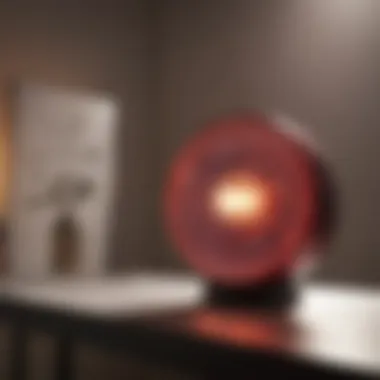Understanding Bright Light Therapy: Mechanisms and Benefits


Intro
Bright light therapy is gaining traction as an effective intervention for various mood and sleep disorders. As awareness surrounding mental health increases, there is a growing interest in exploring innovative treatments. This therapy involves the exposure to bright light, typically through specialized light boxes that mimic natural sunlight. Many individuals suffering from seasonal affective disorder (SAD), insomnia, and other mood-related issues are finding solace in this therapy. Understanding how bright light therapy works and its applications can provide essential insights for researchers, healthcare professionals, and educators alike.
In this guide, we will dissect the fundamental components of bright light therapy, including its mechanisms, applications, and the scientific framework behind its efficacy. By synthesizing current research findings and practical guidelines, we aim to enhance comprehension of this treatment modality and its potential impacts on mental well-being.
Research Context
Background and Rationale
The backdrop for bright light therapy involves growing recognition of the interplay between light exposure and mood regulation. Many studies suggest that insufficient light exposure can significantly affect circadian rhythms, leading to mood disorders and sleep disturbances. Bright light therapy posits that enhancing light exposure can help restore balance and improve mental health.
The rationale for using this therapy stems from its non-invasive nature and minimal side effects compared to pharmacological interventions. As mental health awareness expands, exploring therapeutic options like bright light therapy becomes paramount. The health benefits can range from boosting mood, enhancing focus, to regulating sleep patterns.
Literature Review
A substantial body of research delves into bright light therapy. A review of clinical studies indicates its effectiveness particularly in treating seasonal affective disorder. The findings suggest people often experience significant mood improvement over weeks of treatment. Additionally, studies show positive outcomes for insomnia and depression.
The literature highlights various exposure durations, intensities, and optimal times for therapy. For example, some studies recommend bright light exposure in the morning to align the internal body clock to daytime activities. Others illustrate the benefits of consistent exposure, reinforcing the need for clear guidelines on the effective application of this therapy.
"Light is not merely a component of our environment; it shapes our psychological and physiological states profoundly."
With this understanding, the next logical step involves examining the methodologies employed to gather and analyze data surrounding bright light therapy.
Prologue to Bright Light Therapy
Bright light therapy is increasingly recognized as a valuable approach in treating various mood and sleep disorders. Its relevance stems from the growing body of evidence highlighting its effectiveness, particularly in managing conditions like Seasonal Affective Disorder (SAD), non-seasonal depression, and sleep-related issues. This section lays the foundation for understanding how light exposure can influence mental health, presenting key concepts and considerations for effective usage.
Understanding bright light therapy involves exploring its mechanisms and the science behind its applications. The advances in research have revealed the multifaceted roles that light exposure plays in regulating mood, circadian rhythms, and overall psychological well-being. It serves to enhance the connection between light and mental health, encouraging a broader audience to engage with this therapy as a legitimate treatment option.
Defining Bright Light Therapy
Bright light therapy, often referred to as phototherapy, utilizes exposure to artificial light that mimics natural sunlight. This exposure typically occurs through specially designed light boxes, which emit bright light at an intensity of 10,000 lux or more. The therapy aims to reset the internal clock, allowing individuals to realign their circadian rhythms and improve their mood.
While the therapy may seem straightforward, its effectiveness relies on several factors, including light intensity, duration of exposure, and timing. The goal is to deliver the right amount of light during periods when natural sunlight is limited, often in the winter months or for individuals with erratic sleep patterns.
Historical Context of Light Therapy
The roots of light therapy date back to ancient civilizations, where sunlight was believed to have healing properties. Ancient Greeks and Romans utilized sunlight for health benefits, emphasizing the significance of natural light. The modern application of light therapy began in the late 19th century when researchers began to investigate the physiological effects of light on humans.
In the early 1900s, experiments demonstrated the impact of light on mental health. Researchers noted that patients in psychiatric wards experienced improvements in mood when exposed to natural sunlight. Subsequent scientific inquiry led to the development of phototherapy as a treatment for depression and other mood disorders. Throughout the latter half of the 20th century, myriad studies began validating the therapeutic potential of bright light, establishing its role in modern psychological treatments.
Historically, light therapy has evolved into a recognized and scientific practice, but many still remain unaware of its capabilities and applications. Enhancing Public understanding of rich light therapy's history provides context for its current applications and underscores its significance in mental health management.
Mechanisms of Action
The mechanisms of action involved in bright light therapy are crucial for understanding how this treatment influences mood and various sleep-related disorders. These mechanisms encompass physiological processes that link light exposure to hormonal regulation and circadian rhythms. By unraveling the complexities of these interactions, we can appreciate the potential benefits of bright light therapy in clinical settings.
Role of Melatonin


Melatonin is a key hormone produced by the pineal gland in response to darkness. It regulates sleep-wake cycles and helps maintain a healthy circadian rhythm. Light exposure, particularly blue light, can inhibit melatonin secretion, making bright light therapy effective for resetting sleep patterns. This is especially important for individuals experiencing disruptions in their circadian rhythm, such as night shift workers or people suffering from jet lag.
In the context of seasonal affective disorder (SAD), melatonin levels can fluctuate significantly, leading to mood disturbances. Bright light therapy aims to suppress melatonin production during daylight hours, thus alleviating depressive symptoms. By enhancing daytime alertness and regulating sleep cycles, the therapy indirectly contributes to a more stable emotional state.
Effects on Circadian Rhythms
Circadian rhythms are the body's internal clock, regulating the sleep-wake cycle over a 24-hour period. These rhythms can be disrupted by various factors, including irregular sleep patterns, stress, and environmental changes. Bright light therapy plays a vital role in recalibrating these rhythms. It signals to the body that it is daytime, promoting alertness and cognitive function.
Research shows that consistent exposure to bright light can phase-shift the circadian rhythm, allowing individuals to fall asleep and wake up more comfortably at desired times. This transformation can be particularly advantageous for those with delayed sleep phase disorder or insomnia. Aligning the body’s natural cycles with daily activities improves not only sleep but overall mental health.
Influence on Serotonin Levels
Serotonin is a neurotransmitter intimately linked to mood regulation. Low serotonin levels are often associated with depression and anxiety disorders. Bright light therapy can influence serotonin production by impacting the brain's areas responsible for its synthesis.
Exposure to bright light enhances the production of serotonin, which can improve mood and overall psychological well-being. This is especially significant for individuals suffering from mood disorders, including depression. Scientists suggest that light therapy can serve as a supplement to traditional treatments, enhancing their effects and improving patient outcomes.
Bright light therapy's multifaceted effects, from melatonin regulation to serotonin enhancement, demonstrate its potential as a compelling option for various mood and sleep disorders. As research continues to evolve, deeper insights into these mechanisms will further clarify the role of light in enhancing mental health.
Common Applications of Bright Light Therapy
Bright light therapy has gained recognition for its diverse applications in treating various mood and sleep disorders. Understanding these applications is crucial, as it provides insight into how this therapy functions in addressing specific health conditions. Increased awareness surrounding its benefits can aid health professionals and patients in identifying when to consider this treatment modality.
Treatment of Seasonal Affective Disorder
Seasonal Affective Disorder (SAD) is a type of depression that occurs at a certain time of year, often during the fall and winter months when natural sunlight is limited. Bright light therapy plays a significant role in managing this condition. The application involves exposure to a light box that emits bright light, mimicking natural sunlight. Research has shown that regular use can help alleviate symptoms such as low energy, mood swings, and difficulty concentrating.
Light therapy is often recommended to be used in the morning to effectively reset the body's internal clock. Users might find relief starting with as little as 20 to 30 minutes of exposure daily. This method is especially important for individuals living in regions with long winters and limited daylight hours.
Management of Non-seasonal Depression
Beyond SAD, bright light therapy also offers benefits for managing non-seasonal forms of depression. These may include major depressive disorder and dysthymia. Clinical studies suggest that bright light therapy can improve mood symptoms significantly when used consistently.
In cases where medications are not viable due to side effects or personal preferences, light therapy serves as a valuable alternative or adjunctive treatment. It is usually well-tolerated and poses minimal risks, making it an appealing option for many individuals suffering from chronic depression.
Addressing Sleep Disorders
Sleep disorders, such as insomnia or delayed sleep phase syndrome, can significantly impact quality of life. Bright light therapy can help reset the circadian rhythm, which is beneficial for those experiencing disruptions in their sleep patterns.
For individuals struggling with difficulty falling asleep at appropriate times, exposure to bright light in the morning can signal the brain to promote wakefulness during the day. Conversely, it is advisable to minimize light exposure in the evening to prepare the body for sleep. Many find that consistent use of bright light therapy can lead to better sleep quality and increased daytime energy levels.
Potential in Bipolar Disorder Treatment
Bipolar disorder presents unique challenges due to its fluctuating mood states. Research indicates that bright light therapy may have potential in managing episodes of depression in individuals with bipolar disorder, particularly in conjunction with other treatment strategies.
However, caution is necessary. For some individuals, exposing themselves to bright light can trigger manic episodes. Therefore, careful monitoring and professional guidance are essential when using this treatment for bipolar disorder.
In summary, the applications of bright light therapy extend beyond just Seasonal Affective Disorder. It offers potential advantages in managing various forms of depression, improving sleep disorders, and addressing challenges associated with bipolar disorder. By fostering a deeper understanding of these applications, healthcare providers can make more informed decisions about integrating light therapy into treatment plans.
Scientific Evidence and Research Findings
The scientific foundation of bright light therapy is crucial to understanding its effectiveness and potential applications. Research findings not only support the therapy's benefits for various mood and sleep disorders but also provide insights into its underlying mechanisms of action. Recent studies contribute to a growing body of evidence that advocates for light therapy as a viable treatment modality. By examining both recent clinical trials and the outcomes of meta-analyses, this section aims to clarify the empirical support for bright light therapy, guiding practitioners and researchers alike.


Recent Clinical Trials
Recent clinical trials play a vital role in validating bright light therapy as an effective treatment option. These studies often reflect real-world applications and offer insights into practical considerations for implementation.
- A notable trial conducted by the National Institute of Mental Health tested bright light therapy among participants with seasonal affective disorder (SAD). The results indicated significant reductions in depressive symptoms after several weeks of daily light exposure, reinforcing the therapy's potential in treating mood disorders.
- Another trial focusing on non-seasonal depression involved a comparative study of bright light therapy and antidepressants. Participants receiving light therapy reported similar improvements in mood compared to those on medication, highlighting its efficacy as an alternative treatment.
"Recent clinical trials indicate that bright light therapy significantly improves mood symptoms, making it a valuable tool in mental health treatment."
These findings illuminate the possibilities of integrating bright light therapy into standard treatment protocols. The trials also offer insights into duration and timing of treatment, guiding future research and clinical practice.
Meta-Analyses Outcomes
Meta-analyses synthesize data from multiple studies, providing a broader understanding of bright light therapy's effectiveness. Their comprehensive nature allows for a more nuanced view of the therapy's impact across various populations and conditions.
- One significant meta-analysis evaluated the efficacy of bright light therapy in treating SAD and non-seasonal depression. The analysis revealed a moderate to large effect size, underscoring the therapy’s potential.
- Another meta-analysis examined the effects of timing and light intensity, finding that early morning sessions yielded the best outcomes. This suggests that individualized treatment plans may enhance effectiveness.
- The outcomes consistently illustrate a positive association between bright light therapy and symptom relief, particularly in mood and sleep disorders.
These meta-analyses provide a crucial summary of existing evidence, reinforcing the idea that bright light therapy not only has immediate benefits but also holds long-term therapeutic potential in mental health treatment. Through careful consideration of meta-analytic data, researchers can inform future studies and clinical applications, ensuring that bright light therapy remains a relevant topic in mental health discourse.
Guidelines for Effective Use
Understanding how to effectively use bright light therapy (BLT) is crucial for anyone looking to harness its benefits. Proper guidelines not only enhance the efficacy of the treatment, but also minimize any potential side effects. Those interested in this therapy must carefully consider elements such as optimal light intensity, duration, and the timing of exposure. Each of these factors plays a significant role in ensuring that the desired therapeutic effects are achieved while safeguarding user experience.
Optimal Light Intensity and Duration
The intensity of the light used during therapy is a critical factor. Common recommendations suggest a light intensity ranging from 2,500 to 10,000 lux. A higher intensity at 10,000 lux can yield significant results in a shorter time frame, often requiring only about 20-30 minutes of exposure each day. Conversely, lower intensity levels, around 2,500 lux, may require longer sessions, potentially up to two hours, to achieve similar effects.
For effective use, individuals must also consider the angle of the light source. The light needs to be directed towards the eyes but should not cause discomfort. An ideal distance is typically around 16 to 24 inches from the source. Careful attention to these details ensures maximum exposure to the positive wavelengths that can trigger beneficial physiological responses.
Timing of Treatment
The timing of bright light therapy is as crucial as the intensity. Morning exposure is often more beneficial as it aligns with natural circadian rhythms. This timing can effectively advance the body’s biological clock, helping those with sleep disorders or seasonal affective disorder. Treatments are usually scheduled early in the day, ideally within the first hour after waking.
Another important aspect is consistency. Regular daily sessions at the same time can help stabilize the body’s circadian rhythms. For some, using bright light therapy in the late afternoon or early evening may be effective too, but this should be approached with caution. Such timing can interfere with nighttime sleep for some individuals. Therefore, keeping a journal to track responses to various timings can provide insight into what works best for each person’s unique needs.
Proper adherence to guidelines surrounding light intensity and timing can dramatically enhance the therapy's effectiveness.
Following structured guidelines for bright light therapy is essential for maximizing its mental health benefits. This understanding allows individuals to make informed decisions, helping them improve their well-being while reducing the risk of adverse effects.
Safety Considerations
Safety considerations are a vital aspect of bright light therapy. Understanding them helps ensure safe and effective treatment for individuals seeking relief from mood and sleep disorders. While bright light therapy is generally well-tolerated, it is essential to address potential side effects and specific recommendations tailored for vulnerable populations. This section will outline these considerations in detail.
Potential Side Effects
Despite its benefits, bright light therapy can lead to side effects for some individuals. Common side effects include:
- Eye strain or discomfort: Exposure to bright light can cause temporary discomfort, especially if one is sensitive to light.
- Headaches: Some users report headaches following treatment, particularly if they have a tendency toward migraines.
- Insomnia: Initially, light therapy might disrupt sleep patterns, leading to difficulty falling asleep or remaining asleep. This is often linked to the timing and duration of therapy sessions.
- Nausea: In rare cases, nausea may occur, potentially related to the intensity of light exposure.
It is essential that individuals monitor their reactions and discontinue therapy if severe side effects occur. Consulting with a healthcare provider before starting light therapy can also help assess risks and mitigate potential side effects.


Recommendations for Special Populations
Certain groups may require special considerations when using bright light therapy. These populations include:
- Individuals with bipolar disorder: Those with this condition should exercise caution. Bright light therapy can trigger manic episodes in some cases. Regular monitoring and coordination with a mental health expert are highly recommended.
- Pregnant women: While there is limited research on the effects of bright light therapy during pregnancy, it is best for expectant mothers to consult with their healthcare provider to evaluate benefits and risks.
- People with specific eye conditions: Individuals with conditions like retinal disorders or other sensitivities should seek professional advice prior to treatment. Specialized devices may be necessary to minimize risks.
- Older adults: Sensitivity to light tends to increase with age. Adjustments in light intensity and duration may be necessary to avoid adverse effects.
In general, it is advisable to implement light therapy in a controlled setting, starting with lower intensities and shorter durations, gradually increasing exposure based on individual tolerance. This approach can help facilitate a positive response while minimizing risks.
"The efficacy of bright light therapy largely depends on its implementation. Proper attention to safety can enhance benefits while reducing complications."
In summary, safety considerations related to bright light therapy are significant in guiding users toward informed decisions. Understanding potential side effects and adjusting the therapy for special populations can enhance the overall treatment experience.
Future Directions in Bright Light Therapy Research
Bright light therapy stands at a crossroad of scientific inquiry and clinical application. As mental health issues continue to gain significance on a global scale, understanding and improving methods for treatment is vital. The exploration of future directions in bright light therapy is essential, as it not only has implications for current therapeutic practices but can also lead to innovative approaches that benefit a wider range of patients.
Research in this field has thus far focused on several core applications, primarily targeting mood and sleep disorders. However, there is a growing recognition of the need to expand the scope of bright light therapy beyond these areas. The implications of such research are far-reaching and can lead to enhanced mental well-being across diverse populations. This section delves into emerging technologies and broader applications of bright light therapy, revealing potential advancements waiting to be realized.
Emerging Technologies
The emergence of new technologies is setting the stage for the next wave of breakthroughs in bright light therapy. Innovations in light-emitting diodes (LEDs) and wearable devices promise more personalized and efficient treatment regimens. For instance, developers are investigating adjustable light spectra and intensities in devices that can be worn, allowing for a tailored experience that accounts for individual preferences and needs.
Furthermore, remote monitoring and telehealth capabilities are becoming more prevalent. Such technologies enable healthcare professionals to track patients' responses in real-time and adjust treatments accordingly. This means that instead of a one-size-fits-all approach, patients can receive a more customized method of therapy, potentially leading to greater efficacy in treatment.
New clinical trials utilizing these technologies have shown promise, indicating that they could facilitate broader access and compliance. Ultimately, these tools could empower patients to engage more meaningfully in their own treatment, marking a significant shift in how bright light therapy is administered.
Potential for Broader Applications
The potential for extending bright light therapy into new clinical domains is noteworthy. Research is looking into applications that go beyond mood and sleep disorders, offering promising avenues in areas such as anxiety disorders, post-traumatic stress disorder (PTSD), and even cognitive impairments associated with aging. for example, some preliminary studies suggest that bright light exposure may enhance cognitive functions, particularly in older adults.
In addition, ongoing research is evaluating how bright light therapy can be combined with other treatment options. For instance, integrating bright light therapy with cognitive behavioral therapy could provide complementary benefits for individuals with chronic depression.
"The possibilities for bright light therapy continue to evolve, as researchers push boundaries to uncover its full potential across diverse mental health challenges."
Advancements in understanding the biological mechanisms behind how light affects mood and behavior can also lead to refined therapeutic protocols. Collaborative efforts between psychologists, neuroscientists, and technologists could yield exciting developments. Achieving such interdisciplinary innovations will require sustained interest and investment in bright light therapy research, ensuring it becomes a mainstream treatment option for various disorders.
As the body of evidence grows, it is crucial that the medical community remains receptive to the incorporation of bright light therapy into an integrated treatment framework. Such progress will not only advance patient care but will also reinforce the role of light in promoting mental wellness.
Epilogue
The topic of bright light therapy holds significant importance in the context of mental health treatment strategies discussed in this article. Bright light therapy offers a non-invasive approach to managing various mood disorders, particularly seasonal affective disorder and non-seasonal depression. Its mechanisms involve notable biological processes that align closely with circadian rhythms and neurochemical balances. Understanding these mechanisms provides a foundation for both clinical practice and academic inquiry.
Summary of Key Points
The exploration of bright light therapy reveals several critical insights:
- Mechanisms of Action: Bright light therapy influences melatonin production, modifies serotonin levels, and helps regulate circadian rhythms. These elements are crucial in combating mood disorders and sleep-related issues.
- Applications: It is primarily used in treating seasonal affective disorder, managing non-seasonal depression, addressing sleep disorders, and showing promise in bipolar disorder therapy.
- Scientific Evidence: Various clinical trials and meta-analyses support the efficacy of bright light therapy, confirming its role in enhancing mental well-being.
- Safety and Guidelines: Understanding potential side effects and adhering to guidelines ensures safe and effective use for various populations.
Calls for Continued Research and Awareness
The field of bright light therapy is ripe for ongoing research and awareness initiatives. There is a need for further studies examining:
- Long-term Impacts: More evidence is needed on the long-term effects of bright light therapy, particularly in diverse populations.
- Technological Advancements: Exploring emerging technologies can improve treatment methods and accessibility.
- Broader Applications: Future research might uncover additional applications of bright light therapy in other mental health conditions and challenges.
Continued research can refine the knowledge we have about bright light therapy and enhance its effectiveness as a therapeutic tool for mental health.
Raising awareness about the benefits and practices of bright light therapy can equip both professionals and the general public with valuable insights, ultimately improving mental health outcomes.



